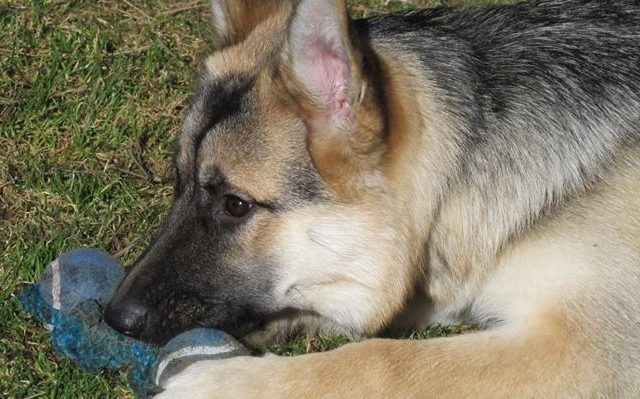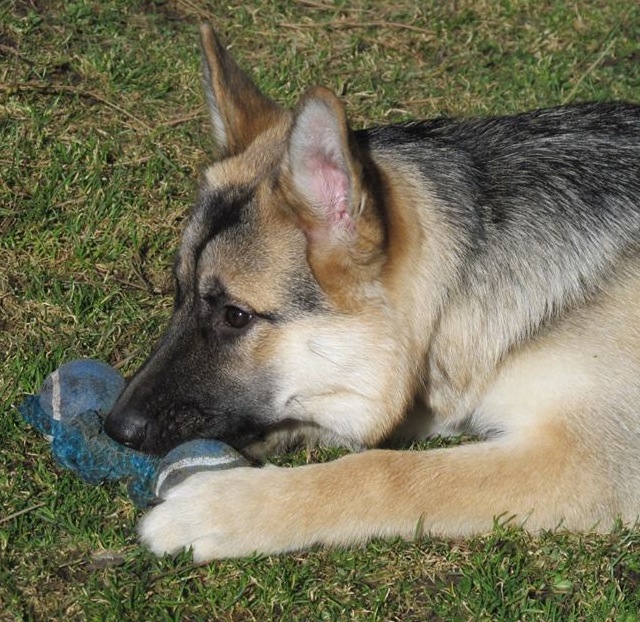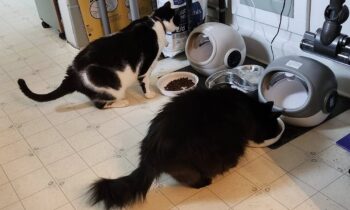
Dogs, cats, and many other household pets can be unwilling to give up something they hold in their mouths, whether it be a toy, a stolen object, or food. It’s a normal, natural reaction.
But what if the animal has something that could harm them, like a sharp object or a huge bar of chocolate? What if they’ve got something valuable, like your favorite shoes or your mobile phone? How do you overcome the animal’s natural reaction—to hold onto what they’ve got—and get the object away from them?
Back in the bad old days of animal training, the answer would’ve been easy: force. Grab the object and force the animal to release it. Force the animal’s mouth open. Force the animal to the floor and hold it down. Force the animal into submission. Punish the animal after the object has been released. Hold him in a submissive position by force to show him that you are the pack leader. Hurt the animal.
Does force work? No.
Even if it did, why the heck would you want a relationship with an animal who is a member of your family to be based on force and fear? Of course it doesn’t work. What happens the next time the animal has something in his mouth that he shouldn’t have? He avoids you. He slinks or runs away when you approach him. He hides. He growls when you get close. He escalates to using his teeth when you grab the object in his mouth. He nips, a warning. He bites.
Why doesn’t force work? Your animal is now terrified when he has something in his mouth and you approach him. He knows what’s coming next, and he is fearful of it. He does not want a confrontation, so he first attempts to avoid it by trying to get away from you. He feels trapped when you pursue and stop him. He may urinate. Your proximity predicts punishment and pain. He generalizes from one situation to the next and soon is fearful of being approached at all.
Animal training today is not grounded in force or fear. In fact, trainers are working with veterinarians, clinic staffs, shelter workers, and behaviorists to establish force- and fear-free protocols for dealing with animals in clinics and shelters across our country, to make veterinary care, grooming, and handling unintimidating to the animals. Yes, even getting shots or having nails trimmed! Your own animals, the pets in your home, can benefit from this well-thought-out and humane approach.
You are responsible for teaching your animal (in this case, primarily your dog, but the information certainly applies to any animal who can carry something in its mouth) to allow you to remove that object from his possession by training the animal that “giving it up” calmly and willingly is rewarding.
You, too, are rewarded when your dog achieves full acceptance of this training. You no longer have to get mad, get mean, or get bitten! You get back the object from your dog before it causes any problems; for example, you won’t have to take him to the pet emergency clinic because he’s swallowed half his weight in chocolate. True, you’ll have to throw away the chocolate unless its wrapping held together, but that’s much better than having to throw away your dog, no?

Don’t let “stealing” start. Police the areas to which your dog has access. Children’s toys are enticing, plus they smell like the kids. If your dog has full access to the children’s rooms and the kids leave toys all over the house, you can’t blame the dog for being attracted. Use doors and baby gates to limit the dog’s access to areas with the most attractive nuisances. Humans’ shoes and personal objects like purses, mobile phones, and underwear are also attractive to dogs. You might not expect your kids to pick up all their toys, but you certainly can have higher expectations of the adult members of your family. Keep that stuff out of doggy’s reach and doggy will never know how attractive it might be.
- Don’t be careless with food left out on counters.
- Close the door to the bathroom when you’re taking medication or putting in your contact lenses.
- Empty lower shelves of bookcases and open displays.
- Child-proof latches on lower doors can work, too.
- Keep waste baskets and garbage bins behind cabinet doors or up out of doggy’s reach.
- Don’t leave the toilet paper where dogs or cats (or ferrets!) can reach it. I know, I know, inconvenient . . . but you’re an intelligent human. I have faith you can deal with the necessity.
- Keep your eyes open every day for “hazards” that might tempt your animal.
Dogs are reinforced every single time they successfully “steal” something you do not want them to have. Food items can be most reinforcing, of course, especially the really good bits—like a steak just off the barbecue (or still on the barbecue!) or an entire loaf of bread. Dogs who have once stolen from the barbecue are much more likely to steal from there again than are dogs who have never stolen from the barbecue. That’s how behavior works. Your job—your first job—is to do your darndest not to let your animal be rewarded by stealing something you have accidentally left out.
But nobody’s perfect—not us, not our critters. One day, your dog will get hold of something you don’t want him to have. Now is the time to start training for that moment. When it happens, you will be glad that you chose to be pro-active, whether you save a steak or a shoe, whether the object endangers your animal or is just something that should be off-limits to him, like a kid’s favorite toy.
Teaching your animal to give up something in his mouth is a matter of making “giving it up” rewarding to the animal—more rewarding, in fact, than holding onto the object and not giving it up. That brings us to the subject of comparative rewards.
Every dog, like every human, is different. We each find certain things highly reinforcing and other things just blah . . . no big deal.
Let’s say you have a gorgeous sunflower growing in your front yard. You’re approached by someone who wishes to cut that sunflower down and take it away. You’re asked what the sunflower is worth to you. You’re offered money, starting at one dollar. You know the sunflower’s worth more than a dollar. You’ve seen cut ones on sale for much more than that. You enjoy the sunflower in your garden, and you realize instantly that it’s not worth one dollar to you to give it up. Then you’re offered one hundred dollars . . .
Here’s your homework. Make a mental list (or ask the whole family to participate and write it all down) of what you think is most rewarding to your animal.
Many of you will list “experiences” first, because what you’ve done with your dog stands out in your mind as some of the dog’s happiest times—riding in the car, walking in the park, swimming at the lake, playing with another dog. Experiences count, big-time, but they’re not always easily and immediately providable as rewards. Even though your dog might be most rewarded by running to the car and going for a ride, when he earns that reward might be in the middle of the night, with you in your jammies and the rest of the family fast asleep. So go past experiences to also include what you can provide almost instantly to your dog—rewards over which you have control and that you can give him anytime. Food and toys may top the list, but remember that many dogs are also rewarded by physical comfort, like sitting on your lap or getting a good chest scratch.
Be creative. List every possible thing or situation that you know your dog likes.
Then, be quantitative. Put that list in order, from what is most rewarding to your dog (exciting, sought-after) at the top to what might be least rewarding (not bad, just blah) at the bottom.
That could take some time. You and your family members may also disagree. One will say, “He likes X best,” and another will argue, “No, he likes Y best!” Keep in mind that what he likes may be situational. He may like X when he’s at home but prefer Y when he’s in public. Nobody’s wrong—it’s only a list! (You’ll find out much more as you put that list to work to teach the behavior that you want— releasing an object in his mouth.)
Next week, we’ll discuss how to train your dog to be willing to release what’s in his mouth.



